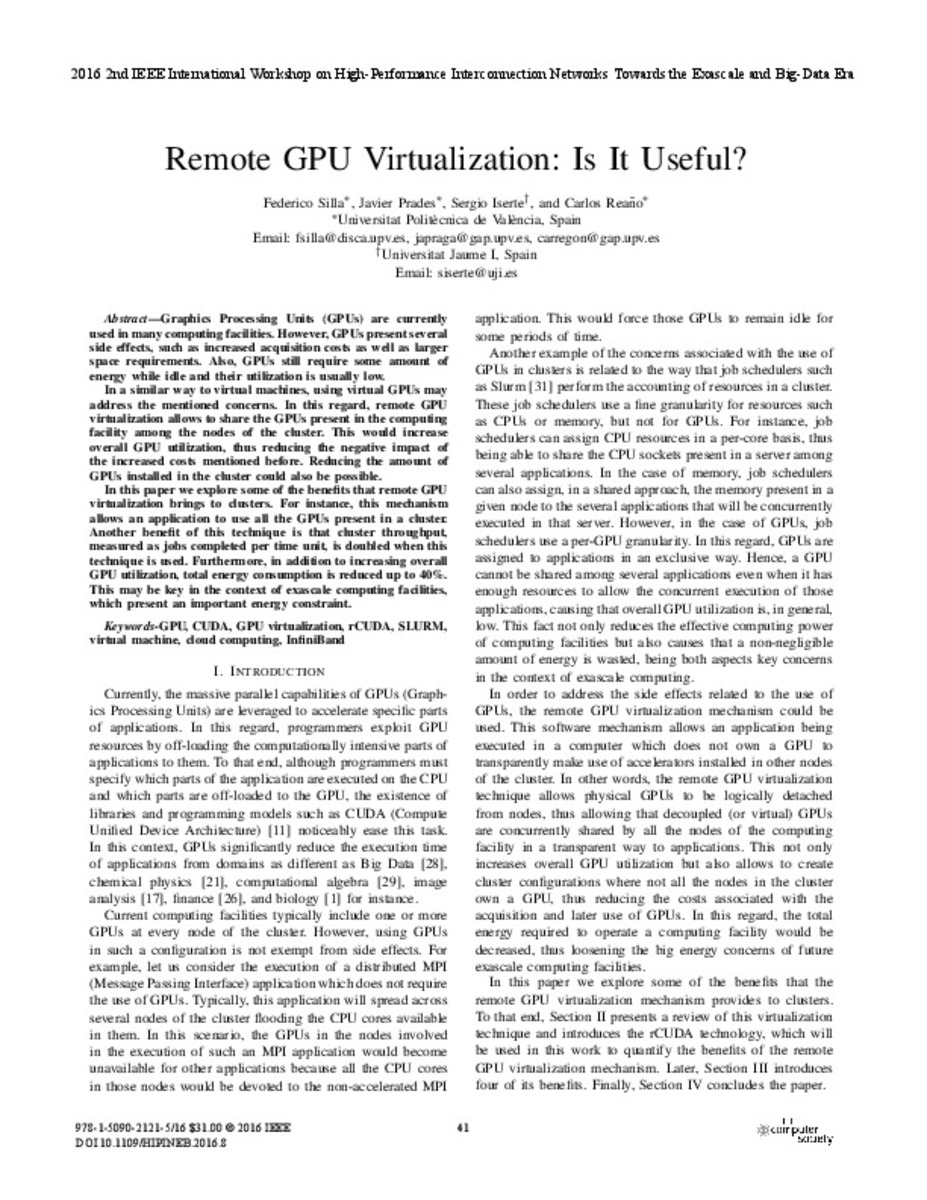Mostrar el registro sencillo del ítem
Remote GPU Virtualization: Is It Useful?
| dc.contributor.author | Silla, Federico | |
| dc.contributor.author | Prades, Javier | |
| dc.contributor.author | Iserte, Sergio | |
| dc.contributor.author | Reaño, Carlos | |
| dc.date.accessioned | 2016-06-08T07:22:23Z | |
| dc.date.available | 2016-06-08T07:22:23Z | |
| dc.date.issued | 2016-03 | |
| dc.identifier.citation | SILLA, Federico, et al. Remote GPU Virtualization: Is It Useful?. En 2016 2nd IEEE International Workshop on High-Performance Interconnection Networks in the Exascale and Big-Data Era (HiPINEB). IEEE, 2016. p. 41-48. | ca_CA |
| dc.identifier.uri | http://hdl.handle.net/10234/160450 | |
| dc.description.abstract | Graphics Processing Units (GPUs) are currently used in many computing facilities. However, GPUs present several side effects, such as increased acquisition costs as well as larger space requirements. Also, GPUs still require some amount of energy while idle and their utilization is usually low. In a similar way to virtual machines, using virtual GPUs may address the mentioned concerns. In this regard, remote GPU virtualization allows to share the GPUs present in the computing facility among the nodes of the cluster. This would increase overall GPU utilization, thus reducing the negative impact of the increased costs mentioned before. Reducing the amount of GPUs installed in the cluster could also be possible. In this paper we explore some of the benefits that remote GPU virtualization brings to clusters. For instance, this mechanism allows an application to use all the GPUs present in a cluster. Another benefit of this technique is that cluster throughput, measured as jobs completed per time unit, is doubled when this technique is used. Furthermore, in addition to increasing overall GPU utilization, total energy consumption is reduced up to 40%. This may be key in the context of exascale computing facilities, which present an important energy constraint. | ca_CA |
| dc.description.sponsorShip | This work was funded by Generalitat Valenciana under Grant PROMETEOII/2013/009 of the PROMETEO program phase II. The author from Universitat Jaume I was supported by project TIN2014-53495-R from MINECO and FEDER. The authors are grateful for the generous support provided by Mellanox Technologies and the equipment donated by NVIDIA Corporation. | ca_CA |
| dc.format.extent | 7 p. | ca_CA |
| dc.format.mimetype | application/pdf | ca_CA |
| dc.language.iso | eng | ca_CA |
| dc.publisher | IEEE | ca_CA |
| dc.relation.isPartOf | 2016 2nd IEEE International Workshop on High-Performance Interconnection Networks in the Exascale and Big-Data Era (HiPINEB) | ca_CA |
| dc.rights | © 2016 IEEE | ca_CA |
| dc.rights.uri | http://rightsstatements.org/vocab/InC/1.0/ | * |
| dc.subject | CUDA | ca_CA |
| dc.subject | GPU | ca_CA |
| dc.subject | GPU virtualization | ca_CA |
| dc.subject | InfiniBand | ca_CA |
| dc.subject | SLURM | ca_CA |
| dc.subject | cloud computing | ca_CA |
| dc.subject | rCUDA | ca_CA |
| dc.subject | virtual machine | ca_CA |
| dc.title | Remote GPU Virtualization: Is It Useful? | ca_CA |
| dc.type | info:eu-repo/semantics/conferenceObject | ca_CA |
| dc.identifier.doi | http://dx.doi.org/10.1109/HIPINEB.2016.8 | |
| dc.rights.accessRights | info:eu-repo/semantics/openAccess | ca_CA |
| dc.relation.publisherVersion | http://ieeexplore.ieee.org/xpls/abs_all.jsp?arnumber=7457766 | ca_CA |







